Ijraset Journal For Research in Applied Science and Engineering Technology
- Home / Ijraset
- On This Page
- Abstract
- Introduction
- Conclusion
- References
- Copyright
Deep Learning Models for Micronutrient Deficiency Detection Using Fingernails
Authors: Kalyanapu Srinivas, Satyavada Hemanth Sai Nivas, Pulagam Tarun Reddy, Akshintala Naga Venkata Durga Rajesh, Jakkireddy Karthika Venkata Satish Reddy , Gotru. Ramcharan Kumar
DOI Link: https://doi.org/10.22214/ijraset.2024.59602
Certificate: View Certificate
Abstract
Despite being common, micronutrient deficiencies are frequently missed because of the shortcomings of traditional diagnostic techniques. Conventional evaluations take a lot of time and may involve intrusive techniques. In order to overcome these obstacles, this project offers a novel approach that makes use of EfficientNetB1 and deep learning to reliably identify micronutrient deficiencies from fingernail images. This non-invasive, effective solution offers a substitute for widespread health monitoring.In order to identify tiny visual cues indicative of different micronutrient deficits, our suggested technique entails training an EfficientNetB1 model on a large dataset of fingernail photos. The model\'s remarkable 99% accuracy rate shows how well it can detect and categorize dietary deficits in a variety of nutrient categories. Through the utilization of EfficientNetB1, we are able to optimize the micronutrient deficiency detection process, providing a scalable and easily accessible approach with significant potential for population-wide health screening. In spite of resolving the widespread problem of underdiagnosed micronutrient deficiencies, this ground-breaking research transforms the diagnostic environment by bringing a streamlined and effective technique. We overcome the drawbacks of conventional diagnostic methods by improving the precision and speed of micronutrient insufficiency detection from fingernail photos by utilizing deep learning and the enhanced capabilities of EfficientNetB1. Our method is accessible due to its non-invasive nature, which makes it a good substitute for general health monitoring.
Introduction
I. INTRODUCTION
Over two billion people worldwide suffer from vitamin insufficiency; according to the World Health Organization (WHO), one in three youngsters do not get enough vitamins. 33% of children under five suffer from vitamin A deficiency, which causes symptoms like reduced immunity and night blindness. Shortages of certain minerals, mainly zinc, iron, and iodine, frequently accompany this issue.Pregnant women and children are among the vulnerable categories who are more at danger. Deficiencies in vitamins A, B, folate, and D are common. Supplementation programmes have helped to lessen the effects of pellagra and scurvy, although vitamin shortages are still common.These inadequacies highlight the need for a deeper comprehension of nutritional requirements by contributing to a number of health issues. Over 2 billion people worldwide suffer from vitamin deficiencies, and the population of the United Arab Emirates is particularly impacted locally. Even in the absence of a famine emergency, US data show that more than 92% of people suffer from at least one vitamin or mineral deficiency, indicating a move away from diets high in nutrients and towards a greater availability of processed foods. Our method aims to address the drawbacks of traditional diagnostic approaches by providing a non-invasive and efficient substitute for comprehensive health monitoring. This ground-breaking study not only addresses the pervasive problem of underdiagnosed micronutrient deficiencies but also revolutionizes the field of diagnosis by presenting a streamlined and effective method. Through the use of deep learning and the sophisticated features of EfficientNetB1, our method improves the accuracy and speed of micronutrient insufficiency detection, offering a scalable and user-friendly approach with substantial promise for population-wide health monitoring.
A. Motivation
The pressing requirement to address the widespread and frequently disregarded problem of vitamin deficiencies is what spurred this research. Traditional diagnostic techniques are ineffective, time-consuming, and intrusive even yet they are frequently used. The motivation behind this project is the desire to use deep learning and EfficientNetB1's capabilities to transform how we identify and fix these shortcomings. Widespread health monitoring could be greatly enhanced by providing a non-invasive and effective method for detecting vitamin deficiencies from fingernail photos.
The drive stems from the goal of overcoming the limitations of traditional diagnostic methods, utilising state-of-the-art technologies to improve speed and precision, and eventually changing the diagnostic environment for improved global health outcomes.The study seeks to significantly improve population-wide health screening and, in turn, the identification and treatment of micronutrient deficiencies on a larger scale by offering a scalable and accessible method.
B. Objectives
- To create and put into practice an advanced deep learning model based on EfficientNetB1 with the aim of precisely detecting vitamin deficiencies in photos of fingernails.
- To use the suggested EfficientNetB1 model to identify and classify various forms of micronutrient deficiencies with a high degree of accuracy.
- The goal is to go above and beyond industry norms and offer researchers and health professionals a trustworthy tool.
- To concentrate on enhancing the effectiveness and speed of micronutrient insufficiency detection by utilizing EfficientNetB1's sophisticated features and maximizing model performance.
- To incorporate the created model into a structure that aids in public health screening programmes. The goal is to offer a scalable solution that is simple to use and apply to a wide range of populations.
C. Existing Systems
Effective categorization of fingernails is important in several domains, including occupational health, dermatology, and cosmetology. In the past, standardised grading scales and visual inspection by qualified personnel have been the mainstay of manual assessment procedures. These methods require a lot of work and effort, but they also have subjectivity and inter-rater variability problems. As such, there's been an increasing amount of interest in automated systems that employ machine learning and image processing methods to categorise and objectively assess fingernail characteristics.
But even with all of their potential, automated systems face a number of difficulties. The variety of nail appearances is a significant barrier that can restrict the applicability of trained models to various populations or circumstances. Large, high-quality training datasets are also necessary for the creation of reliable automated systems, but they can be hard to come by or difficult to acquire. Furthermore, rigorous thought and validation are needed to guarantee the results' interpretability and minimise any potential biases in algorithmic decision-making. In order to fully utilise automated fingernail efficiency categorization systems in clinical and practical contexts, it is imperative that these issues be resolved.
II. RELATED WORK
In 2019, Aishwarya, Goel, and Nijhawan completed a study that uses deep learning techniques to examine a crucial element of dermatological health [1]. The research uses a deep learning approach to improve diagnostic capabilities, focusing on the categorization of Onychomycosis, a prevalent fungal condition affecting nails. This study's literature analysis most likely examines the state of dermatological diagnostic techniques today and highlights the need for increased precision and efficacy in the diagnosis of onychomycosis. Such nail illnesses may be misdiagnosed due to the imprecision of traditional diagnostic techniques. The authors want to overcome shortcomings and gaps in current diagnostic techniques by utilizing deep learning to promote automated and accurate onychomycosis classification.
An interesting analysis of the application of nail image processing algorithms for disease identification can be found in the review written in 2019 by V. V. Juna and D. Dhananjayan [2]. With an emphasis on current developments in digital and analogue design, the paper probably reviews the literature to provide a thorough summary of advances in nail image processing in relation to illness diagnosis. The review probably looks at how image processing technologies might improve the precision and effectiveness of illness detection from nail images, which are useful diagnostic indicators for a range of medical problems. In an effort to provide a comprehensive overview of the state-of-the-art in nail image processing for disease diagnosis, the writers probably address approaches, difficulties, and new developments in the field.
The research conducted by S. Gandhat, S. Avhad, R. Alawadh, and N. Bajpai is probably concentrated on the detailed analysis and interpretation of nail photos for therapeutic intents[3]. The study, which was published in the International Journal of Computer Applications, probably explores the examination and interpretation of nail images in order to glean important information for medical diagnoses. The writers might investigate different traits and visual clues found in nail photos that might point to underlying medical issues. The development of automated methods for disease identification based on nail image analysis may benefit from such an analysis.
It is most likely the goal of the paper written by Y. A. Gunge and T. S. Indi to build and investigate a diagnostic method for early illness identification using image processing of human nails [6]. The study, which was published in the International Journal of Information Technology and Computer Science, most likely looks into the possibility of using nail photos as a diagnostic tool to find illnesses early on.
The authors may have suggested a system that uses image processing methods to examine visual clues in nail photos in order to find patterns or abnormalities linked to different illnesses. The article probably provides an overview of the design, outcomes, and ramifications of their suggested early illness diagnosis system, offering insightful information about the nexus between image processing and medical diagnostics.
An integrated deep learning framework is used in the paper by R. Nijhawan, R. Verma, Ayushi, S. Bhushan, R. Dua, and A. Mittal to provide a novel approach for the identification of nail illnesses [9]. The study, which was presented at the 13th International Conference on Signal-Image Technology & Internet-Based Systems, likely presents a thorough methodology that combines different deep learning techniques to improve the precision and effectiveness of nail condition diagnosis. The authors most likely go into detail on the intricacies of their suggested framework, such as the deep learning models that are utilised, the dataset that is used for training and validation, and the outcomes that are attained. This study adds to the expanding corpus of knowledge in medical image analysis by shedding light on the promise of integrated deep learning frameworks for the detection of nails.
A. EfficientNetB1
Within the EfficientNet family, EfficientNetB1 is a convolutional neural network architecture that is renowned for its remarkable efficiency for both model size and computational cost. EfficientNetB1, created in 2019 by Mingxing Tan and Quoc V. Le, is intended to provide optimal results for a variety of image classification applications. In order to attain the ideal balance, the architecture uses a compound scaling technique that adjusts the network's depth, width, and resolution evenly. Because of this, EfficientNetB1 can maintain its computational economy while offering higher accuracy, which makes it a good fit for contexts with limited resources, like edge computing applications or mobile devices.
Network depth, width, and resolution are all equally scaled thanks to a new scaling parameter termed compound scaling, which is introduced by the EfficientNetB1 design. This novel method ensures that the model adjusts to varying task complexities by tackling the difficult task of striking a balance between computing efficiency and model complexity. EfficientNetB1's ability to leverage compound scaling allows it to achieve state-of-the-art performance on a variety of image classification benchmarks with a significantly smaller number of parameters than other architectures. This makes it a desirable option for real-world applications on a budget.
In the parameters mentioned, an upsampling network with decoder blocks is used to implement EfficientNet-B1. This design uses a 2×2 upsampling 2D convolution operation with a stride of 2 applied to the output of the previous layer to generate each decoder block. Following this procedure, the matching feature maps from the encoder section are concatenated with the output. As the foundation of every decoder block, this concatenated tensor is subsequently processed through two convolution layers with batch normalisation and Rectified Linear Unit (ReLU) activation.
Rebuilding higher-resolution feature maps from the compressed representations acquired in the encoder step requires the precise sequencing of these decoder blocks.
A 5x5 input map will provide a 3x3 output feature map when a convolution operation with a 3x3 kernel size, 1x1 padding, and 2x2 stride is applied. This is due to the fact that the stride reduces the output size by moving the kernel by 2 pixels. The output feature map that is produced when this convolution is applied to the 3x3 feature map is 2x2. The influence of the convolution operation on the spatial dimensions of the input features is what causes this size reduction in the output feature map
The last layer of the architecture is crucial to producing the final result. It has a softmax activation function and is organised as a convolutional layer. This layer's channel number is chosen to correspond with the target classes and the model's classification or segmentation goals.
Furthermore, this last layer's output picture size stays constant with the input image size, guaranteeing that the network generates predictions that match the input data in terms of spatial alignment. For multi-class classification tasks, the softmax activation is frequently used. It normalises the network's raw output into probability distributions for each class, making it easier to make decisions based on the highest projected probabilities.
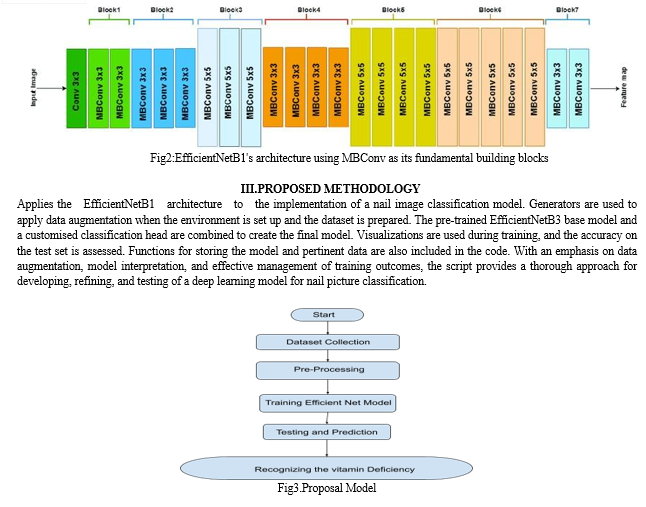
A. Dataset Collection
Maintaining general health, including the health of nails, depends critically on blood circulation, protein, and several vitamins, including B, B12, C, D, and B2. Each category, which contains about 110 photos of nails with deficiencies, offers a thorough depiction of several nutritional factors from a dataset of 800 photographs. Nail deficiencies and their related symptoms might be useful markers of underlying medical conditions. Nail abnormalities may be related to impairments in blood circulation, which may reflect the effects of insufficient oxygen and nutrition delivery. Protein deficiency can cause brittle and weak nails, demonstrating how essential protein is to preserving the strength of nails. Changes like discolouration and brittle texture may indicate vitamin B deficiency, highlighting the significance of this vitamin group for overall nail health. Vitamin D deficiency may be a factor in problems including dryness and peeling, while vitamin C plays a part in collagen formation, which influences nail structure. The relationship between nail health and nutrition is highlighted by the possibility that vitamin B2 deficits could show up as ridges or lines on nails. The diversified dataset makes it possible to create a strong model that can recognise and comprehend many types of nutritional deficiencies from nail photos, which advances nutritional monitoring and healthcare diagnoses.
B. Data Preparation
During the data preparation stage, a collection of data is selected with an emphasis on nutritional deficits that affect the health of nails. This includes topics like blood flow, protein, and different vitamins (B, B12, C, D, and B2). The 800 photos in the dataset are divided into about 110 photographs for each deficit category.
In order to train a strong classification model that can recognise and differentiate between various nutritional deficits based on visual cues in nail photos, a diverse dataset is essential. After that, the dataset is divided into training, testing, and validation sets. To improve model generalisation, data augmentation strategies like flipping are used. A representative and well-balanced dataset is guaranteed for the training of a nail health classification model thanks to this careful preparation.
C. Preprocessing
Preparing the dataset for efficient training of a nail health classification model requires a number of crucial actions during the preprocessing phase. The dataset is initially arranged and classified into four categories of deficiencies: circulatory system, protein, and several vitamins (B, B12, C, D, and B2). To guarantee fair representation in the dataset, each category is balanced.
D. Resize
Displaying the loaded image from the specified directory to the console displays the shape using print(img.reshape). But the shape that is visible is (67, 66, 4), which means that the image has 67 pixels for height, 66 pixels for width, and 4 channels.Three channels are typically present in an image: red, green, and blue. An RGB image with the shape (67, 66, 3) is considered standard. Given the existence of a fourth channel, which is thought to represent the alpha (transparency) channel, the picture may be in the RGBA format.
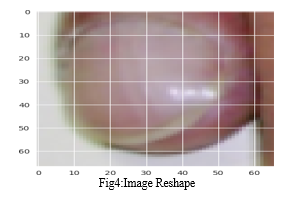
E. Pre-Trained Model
A neural network that has been trained on a sizable dataset for a particular task before being applied to a different but similar task is known as a pretrained model. Pretrained models are primarily beneficial because they can extract features and hierarchical representations from large amounts of data, making them useful feature extractors. Pretrained models, like those pre trained on ImageNet for image-related tasks or models pre trained on large language corpora for natural language understanding, are widely used in computer vision, processing, and other domains. They have shown to be able to generalize well to new tasks with limited data.
By utilizing insights from a variety of datasets, this transfer learning method helps overcome the difficulty of training deep neural networks from scratch. By fine-tuning the parameters of pretrained models to the unique features of the target dataset, high-performance models can be developed even in situations with a dearth of labeled data.
The mentioned callback is a flexible tool that may be used to improve a machine learning model's training process. It especially addresses the drawbacks of individual callbacks, such Reduce Learning Rate on Plateau, Early Stopping, and Model Checkpoint in Keras. It provides an all-inclusive solution with extra features by merging these functionalities. Notably, at the conclusion of each epoch, the callback offers a comprehensible and understandable summary of the model's performance, which facilitates monitoring and assessment.
Flexibility and convenience are offered during model training by the incorporation of an interactive element that lets the user choose whether to end training or how many more epochs to go.Enhancing adaptability and promoting more effective and efficient model training is the callback's primary focus on tracking training correctness and dynamically varying the learning rate until a user-defined threshold is reached. To further ensure optimal outcomes, the callback guarantees that the model returned always reflects the weights from the epoch with the highest performance on the given metric.
IV. RESULTS
A. Evaluation and Metrics
A classifier's standard evaluation is based on a number of predefined performance indicators. Our models are assessed using the following metrics: accuracy, Specificity, F-score, Precision, and Recall. When evaluating the effectiveness and capacity for generalization of machine learning models, learning curves are an essential tool. The evolution of training and validation losses as the number of training instances increases gradually is depicted by these curves. Learning curves provide information about the behavior of the model, especially with regard to overfitting and underfitting, by gradually adding new cases. While an underfit model might not gain much from more examples, an overfit model might benefit from having more training instances to improve performance on unknown data. The accuracy and loss curves are two that are frequently studied curves. Figure 5 shows the loss curve, which shows the model's loss over different epochs and how well it fits the training set.
The number of iterations of the complete training dataset that the model goes through during training is indicated by the x-axis, which stands for epochs. The value of the selected loss function (such as categorical cross entropy or mean squared error) at each epoch is shown on the y-axis, which stands for loss. Thus, the learning curve offers insights into the convergence and performance of the model by showing how the loss varies across subsequent epochs.
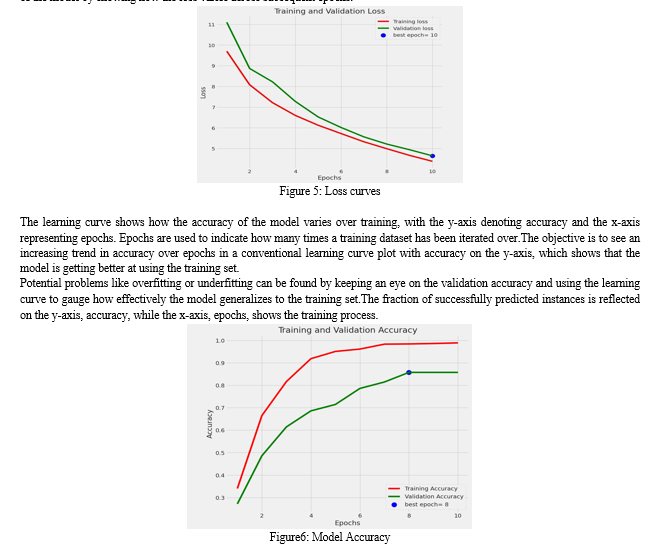
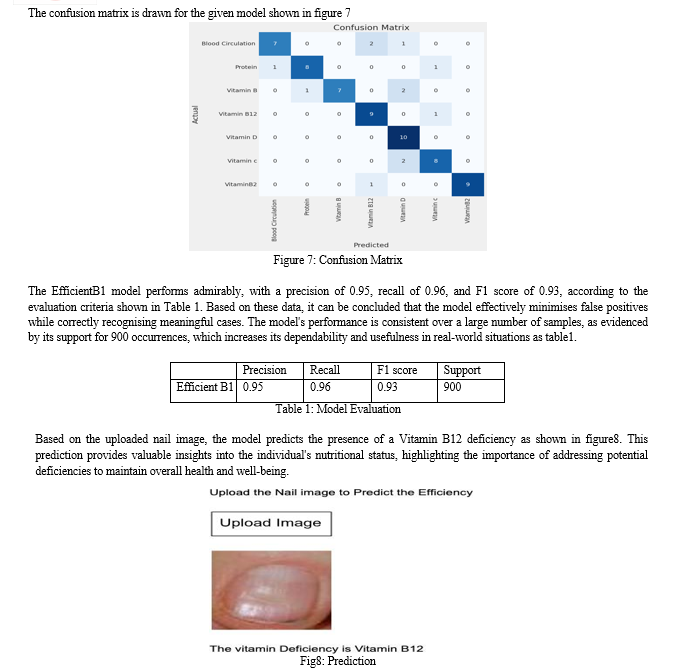
V. FUTURE SCOPE
In order to further improve and use this idea, there will be more work to be done in the future. First, a wider range of datasets covering a greater variety of demographic traits and dietary circumstances might be used to validate the model's robustness. Furthermore, exploring the incorporation of real-time data and creating an intuitive interface may make the actual application of health monitoring easier. To increase the model's usefulness, investigate the possibility of transfer learning and fine-tuning on linked health issues. Collaboration with healthcare organisations and professionals may also yield insightful information for improving the model's applicability and accuracy in clinical situations. The project will stay at the forefront of micronutrient deficiency identification thanks to ongoing updates, adaptations to new technologies, and research in the fields of deep learning and health diagnostics.
Conclusion
At the end of the work, the importance of using deep learning methods more especially, EfficientNetB1 for the identification of vitamin deficiencies in fingernail photos is highlighted. Because of the shortcomings in conventional diagnostic techniques, micronutrient deficiencies are common but frequently go unnoticed. Using EfficientNetB1\'s capabilities, the suggested method successfully classifies and identifies a variety of dietary deficiencies from fingernail pictures with an astounding accuracy rate of 99%. By overcoming the issues raised by traditional evaluation techniques, this non-invasive and efficient system offers a workable substitute for comprehensive health monitoring. By proposing a streamlined and effective technique, the initiative not only solves the prevalent issue of underdiagnosed micronutrient deficiencies, but it also completely changes the diagnostic landscape. The approach provides scalability and accessibility using deep learning and the optimized characteristics of EfficientNetB1, with significant potential for large-scale population-wide health screening. By providing a useful tool for early detection and intervention in addressing micronutrient deficiencies and enhancing general public health, the ground-breaking research advances diagnostic paradigms.
References
[1] Aishwarya, & Goel, Akansha & Nijhawan, Rahul. (2019). A Deep Learning Approach for Classification of Onychomycosis Nail Disease. 10.1007/978-3-030- 30577-2_98. [2] V. V. Juna and D. Dhananjayan, A review on nail image processing for disease detection, Recent Trends Analog Des. Digit. Devices, vol.2, no.3, pp.1-7, 2019. [3] S. Gandhat, S. Avhad, R. Alawadh, and N. Bajpai, “Study and Analysis of Nail Images of Patients,” Int. J. Comput. Appl., vol. 143, no. 13, pp. 38–41, 2016. [4] Mohammad Omid Khairandish, Ruchika Gupta & Meenakshi Sharma, “A Hybrid Model of Faster R-CNN and SVM for Tumor Detection and Classification of MRI Brain Images,\" International Journal of Mechanical and Production Engineering Research and Development (IJMPERD) , Vol. 10, Issue 3,pp, 6863–6876. [5] H. A. L. M. Usawi, “- Infectious Diseases,” vol. 16, no. 3, pp. 311–312, 2012. [6] Y. A. Gunge and T. S. Indi, “Early Stage Disease Diagnosis System Using Human Nail Image Processing,” Int. J. Inf. Technol. Comput. Sci., vol. 8, no. 7, pp. 30–35, 2016. [7] Shaik. Bajid Vali, A. K. Sharma & Syed Musthak Ahmed, “Significance of Images and Algorithms of Image Processing for Detection and Determination of Diabetes at Early Stage”, International Journal of Electronics and Communication Engineering (IJECE) ,Vol. 6, Issue 5,pp; 17-28. [8] Nijhawan, Rahul & Joshi, Deepankar & Narang, Naman & Mittal, Aditya & Mittal, Ankush. (2019). A Futuristic Deep Learning Framework Approach for Land Use-Land Cover Classification Using Remote Sensing Imagery. 10.1007/978-981- 13-0680-8_9. [9] R. Nijhawan, R. Verma, Ayushi, S. Bhushan, R. Dua and A. Mittal, \"An Integrated Deep Learning Framework Approach for Nail Disease Identification,\" 2017 13th International Conference on Signal-Image Technology & Internet-Based Systems (SITIS), Jaipur, 2017, pp. 197-202. [10] M. Dhivya, S. Deepa, S. Anbumani & R. Kavin, “Detection and Grading of Cancer Using Histopathological Image Analysis”, International Journal of Electronics and Communication Engineering (IJECE) ,Vol. 3, Issue 2,pp, 59-68. [11] Cynthia Hayat, Barens Abian, \"The Modeling of Artificial Neural Network of Early Diagnosis for Malnutrition with Backpropagation Method\", 2018. [12] Bambang Lareno, Liliana Swastina, Husnul Maad Junaidi, \"IT Application to Mapping The Potential of Malnutrition Problems, 2018. [13] Anutosh Maitra, Rambhau Eknath Rote, Nataraj Kuntagod, \"Managing Child Malnutrition via Digital Enablement: Insights from a Field Trial\", 2017. [14] Basavaraj Hiremath & SC Prasannakumar, “Automated Evaluation of Breast Cancer Detection Using SVM Classifier”, International Journal of Computer Science Engineering and Information Technology Research (IJCSEITR) ,Vol. 5, Issue 1,pp, 11-20. [15] Archana Ajith, Vrinda Goel, \"Digital Dermatology Skin Disease Detection. Model using Image Processing\", 2017. [16] Kyamelia Roy, Sheli Sinha Chaudhuri, \"Skin Disease detection based on different Segmentation Techniques\", 2019. [17] V. Maeda-Gutiérrez et al., Comparison of convolutional neural network architectures for classification of tomato plant diseases, Appl. Sci., vol.10, no.4, DOI: 10.3390/app10041245, 2020. [18] L. Alzubaidi, J. Zhang, A. J. Humaidi et al., Review of deep learning: Concepts, CNN architectures, challenges, applications, future directions, Journal of Big Data, vol.8, DOI: 10.1186/s40537-021- 00444-8, 2021. [19] M. Yani, B. Irawan and C. Setiningsih, Application of transfer learning using convolutional neural network method for early detection of Terry’s nail, J. Phys. Conf. Ser., DOI: 10.1088/1742- 6596/1201/1/012052, 2019. [20] J. Jefferson and P. Rich, Melanonychia, Dermatol. Res. Pract., DOI: 10.1155/2012/952186, 2012. [21] K. E. Spicknall, M. J. Zirwas and J. C. English, Clubbing: An update on diagnosis, differential diagnosis, pathophysiology, and clinical relevance, J. Am. Acad. Dermatol., vol.52, no.6, pp.1020- 1028, DOI: 10.1016/j.jaad.2005.01.006, 2005. [22] B. M. Piraccini and A. Alessandrini, Onychomycosis: A review, J. Fungi, vol.1, no.1, pp.30-43, DOI: 10.3390/jof1010030, 2015.
Copyright
Copyright © 2024 Kalyanapu Srinivas, Satyavada Hemanth Sai Nivas, Pulagam Tarun Reddy, Akshintala Naga Venkata Durga Rajesh, Jakkireddy Karthika Venkata Satish Reddy , Gotru. Ramcharan Kumar. This is an open access article distributed under the Creative Commons Attribution License, which permits unrestricted use, distribution, and reproduction in any medium, provided the original work is properly cited.
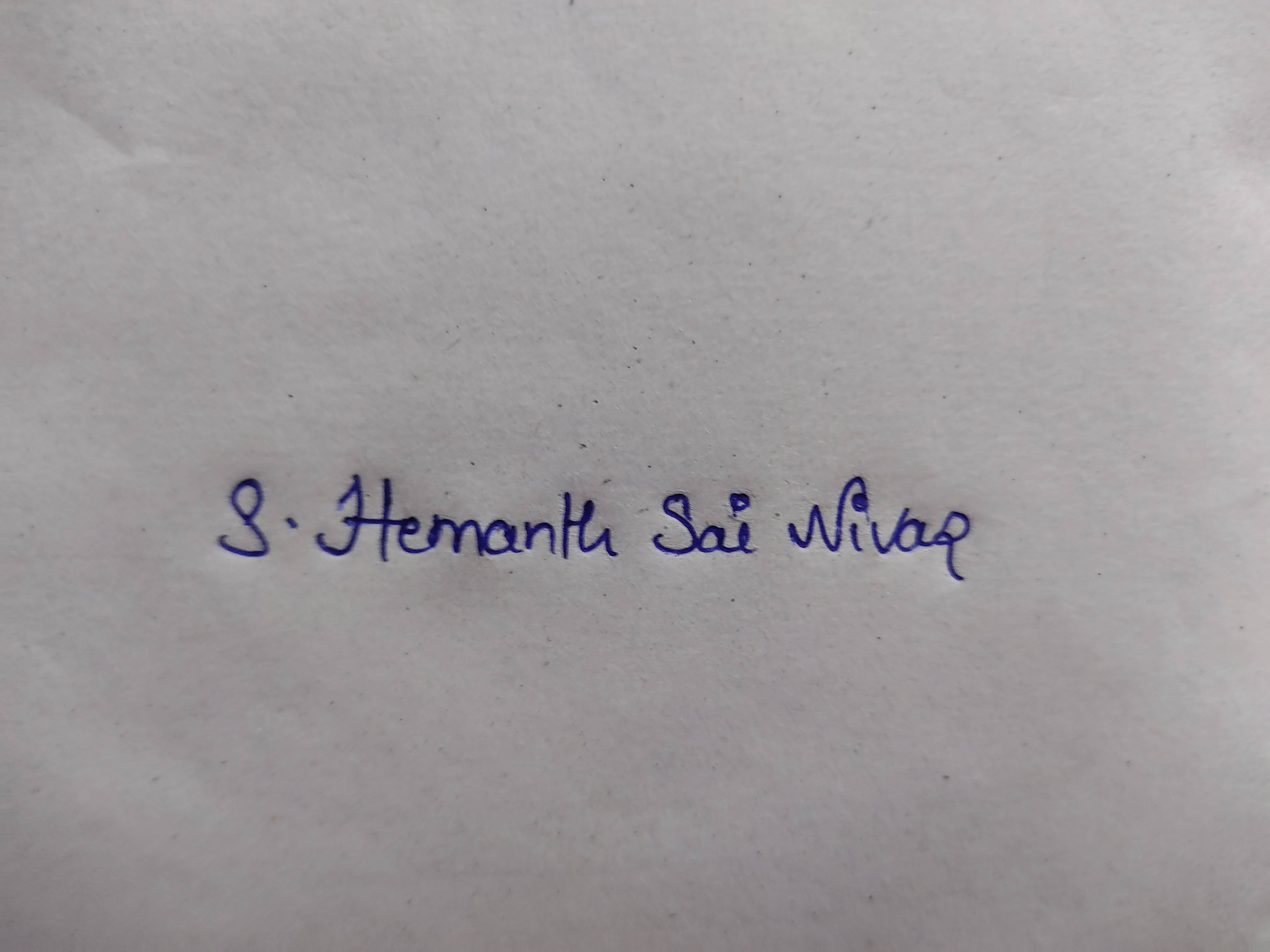
Download Paper
Paper Id : IJRASET59602
Publish Date : 2024-03-30
ISSN : 2321-9653
Publisher Name : IJRASET
DOI Link : Click Here
 Submit Paper Online
Submit Paper Online

